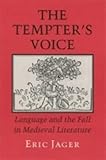The Tempter's Voice : Language and the Fall in Medieval Literature / Eric Jager.
Material type: TextPublisher: Ithaca, NY : Cornell University Press, [2018]Copyright date: ©2006Description: 1 online resource (352 p.) : 7 halftonesContent type:
TextPublisher: Ithaca, NY : Cornell University Press, [2018]Copyright date: ©2006Description: 1 online resource (352 p.) : 7 halftonesContent type: - 9781501721823
- 809/.93382 20
- online - DeGruyter
| Item type | Current library | Call number | URL | Status | Notes | Barcode | |
|---|---|---|---|---|---|---|---|
 eBook
eBook
|
Biblioteca "Angelicum" Pont. Univ. S.Tommaso d'Aquino Nuvola online | online - DeGruyter (Browse shelf(Opens below)) | Online access | Not for loan (Accesso limitato) | Accesso per gli utenti autorizzati / Access for authorized users | (dgr)9781501721823 |
Frontmatter -- CONTENTS -- ILLUSTRATIONS -- ACKNOWLEDGMENTS -- ABBREVIATIONS -- NOTE ON BIBLICAL CITATIONS -- INTRODUCTION -- Part One. Augustine's Garden -- 1. The School of Paradise -- 2. The Genesis of Hermeneutics -- 3. The Garden of Eloquence -- Part Two. The Medieval Garden -- 4. The Old English Epic of the Fall -- 5. The Seducer and the Daughter of Eve -- 6. The Carnal Letter in Chaucer's Earthly Paradise -- Epilogue. Signs of the Fall: From the Middle Ages to Postmodernism -- Bibliography -- Index
restricted access online access with authorization star
http://purl.org/coar/access_right/c_16ec
Why was the story of Adam, Eve, and the Serpent so important to medieval literary culture? Eric Jager argues that during the Middle Ages the story of the Fall was incorporated into a comprehensive myth about language. Drawing on a wide range of texts, Jager shows how patristic and medieval authors used the Fall to confront practical and theoretical problems in many areas of life and thought—including education, hermeneutics, rhetoric, feudal politics, and gender relations. Jager explores the Fall's meaning for clergy and laity, nobles and commoners, men and women.Among the works Jager discusses are texts by Ambrose, Augustine, the early Christian poet Avitus, and scholastic authors; Old English biblical epics; Middle English spiritual writings; French courtesy books; and the poetry of Dante and Chaucer. Examples from the visual arts are included as well. Jager links medieval interpretations of the Fall to underlying cultural anxieties about the ambiguity of the sign, the instability of oral tradition, the pleasure of the text, and the many rhetorical guises of the tempter's voice. He also assesses the modern and postmodern legacy of the Fall, showing how this myth continues to embody central ideas concerning language.The Tempter's Voice will be essential reading for scholars and students in such fields as medieval studies, literary theory, gender theory, comparative literature, cultural history, and the history of religion.
Mode of access: Internet via World Wide Web.
In English.
Description based on online resource; title from PDF title page (publisher's Web site, viewed 26. Apr 2024)


